
(a)
How far above the ground will Domingo be when his seat reaches the top, if the radius of the Ferris wheel is 36 feet?
(a)
Answer to Problem 49E
Explanation of Solution
Given information: Entertainment: Domingo decides to ride the Ferris wheel at the local carnival. When he gets into the seat that is at the bottom of the Ferris wheel, he is 4 feet above the ground.
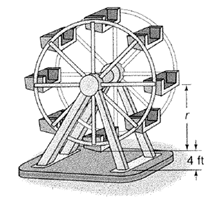
Calculation:
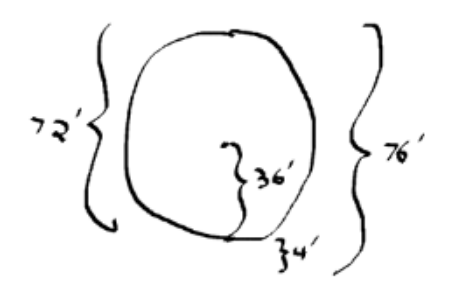
He will be two radii and four feet or,
(b)
How far above the ground is Domingo when the Ferris wheel stops, if the Ferris wheel rotates
(b)
Answer to Problem 49E
Explanation of Solution
Given information: Entertainment: Domingo decides to ride the Ferris wheel at the local carnival. When he gets into the seat that is at the bottom of the Ferris wheel, he is 4 feet above the ground.
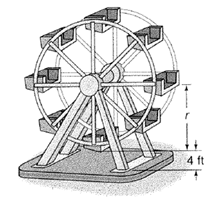
Calculation:
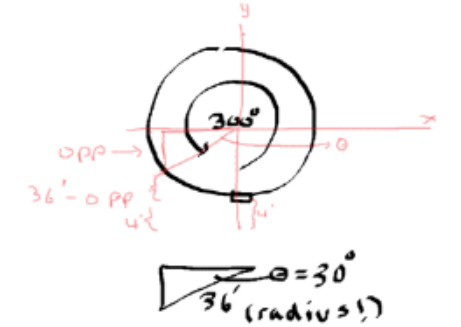
Study the sketch for a minute. After a
4 + 36 = 40
If we subtract the length of this opposite side from 40, it will give us his height above ground.
For a 30-60-90 triangle, the short side is always half the hypotenuse. The hypotenuse is a radius so it is 36 feet so the short side is 18 feet. So he is 18 feet below the x-axis which was 40 feet.
So he is 22 feet above the ground.
(c)
How far above the ground is Domingo when the Ferris wheel rotates
(c)
Answer to Problem 49E
Explanation of Solution
Given information: Entertainment: Domingo decides to ride the Ferris wheel at the local carnival. When he gets into the seat that is at the bottom of the Ferris wheel, he is 4 feet above the ground.
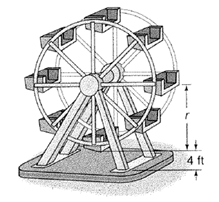
Calculation:
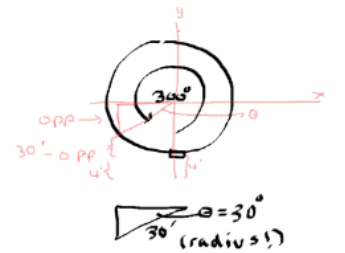
Study the sketch for a minute. After a
4 + 33 = 34
If we subtract the length of this opposite side from 34, it will give us his height above ground.
For a 30-60-90 triangle, the short side is always half the hypotenuse. The hypotenuse is a radius so it is 30 feet so the short side is 15 feet. So he is 15 feet below the x-axis which was 34 feet.
So he is 19 feet above the ground.
(d)
To write:An expression for the distance from the ground to Domingo after the Ferris wheel rotates
(d)
Answer to Problem 49E
Explanation of Solution
Given information: Entertainment: Domingo decides to ride the Ferris wheel at the local carnival. When he gets into the seat that is at the bottom of the Ferris wheel, he is 4 feet above the ground.
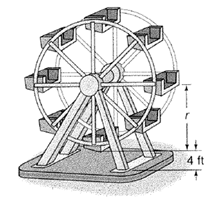
Calculation:
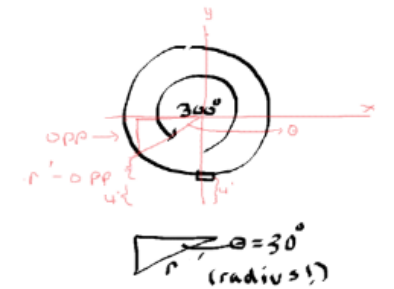
Study the sketch for a minute. After a
4 + r
If we subtract the length of this opposite side from 4 + r, it will give us his height above ground.
For a 30-60-90 triangle, the short side is always half the hypotenuse. The hypotenuse is a radius so it is r feet so the short side is
So he is
Chapter 5 Solutions
Advanced Mathematical Concepts: Precalculus with Applications, Student Edition
Additional Math Textbook Solutions
Elementary Statistics: Picturing the World (7th Edition)
Elementary Statistics (13th Edition)
Introductory Statistics
Thinking Mathematically (6th Edition)
Basic Business Statistics, Student Value Edition
A First Course in Probability (10th Edition)
- 8 L 8 e ipx dxarrow_forwardFind the Taylor polynomial T³(×) for the function f centered at the number a. f(x) = xe-2x a = 0 T3(x) =arrow_forwardFor each graph in Figure 16, determine whether f (1) is larger or smaller than the slope of the secant line between x = 1 and x = 1 + h for h > 0. Explain your reasoningarrow_forward
- Points z1 and z2 are shown on the graph.z1 is at (4 real,6 imaginary), z2 is at (-5 real, 2 imaginary)Part A: Identify the points in standard form and find the distance between them.Part B: Give the complex conjugate of z2 and explain how to find it geometrically.Part C: Find z2 − z1 geometrically and explain your steps.arrow_forwardA polar curve is represented by the equation r1 = 7 + 4cos θ.Part A: What type of limaçon is this curve? Justify your answer using the constants in the equation.Part B: Is the curve symmetrical to the polar axis or the line θ = pi/2 Justify your answer algebraically.Part C: What are the two main differences between the graphs of r1 = 7 + 4cos θ and r2 = 4 + 4cos θ?arrow_forwardA curve, described by x2 + y2 + 8x = 0, has a point A at (−4, 4) on the curve.Part A: What are the polar coordinates of A? Give an exact answer.Part B: What is the polar form of the equation? What type of polar curve is this?Part C: What is the directed distance when Ø = 5pi/6 Give an exact answer.arrow_forward
- New folder 10. Find the area enclosed by the loop of the curve (1- t², t-t³)arrow_forward1. Graph and find the corresponding Cartesian equation for: t X== y = t +1 2 te(-∞, ∞) 42,369 I APR 27 F5 3 MacBook Air stv A Aa T 4 DIIarrow_forwardMiddle School GP... Echo home (1) Addition and su... Google Docs Netflix Netflix New folder 9. Find the area enclosed by x = sin²t, y = cost and the y-axis.arrow_forward
- 2. Graph and find the corresponding Cartesian equation for: (4 cos 0,9 sin 0) θ ε [0, 2π) 42,369 I APR 27 3 MacBook Air 2 tv A Aaarrow_forward30 Page< 3. Find the equation of the tangent line for x = 1+12, y = 1-3 at t = 2 42,369 APR A 27 M . tv NA 1 TAGN 2 Aa 7 MacBook Air #8arrow_forwardEvaluate the following integrals as they are writtenarrow_forward
 Calculus: Early TranscendentalsCalculusISBN:9781285741550Author:James StewartPublisher:Cengage Learning
Calculus: Early TranscendentalsCalculusISBN:9781285741550Author:James StewartPublisher:Cengage Learning Thomas' Calculus (14th Edition)CalculusISBN:9780134438986Author:Joel R. Hass, Christopher E. Heil, Maurice D. WeirPublisher:PEARSON
Thomas' Calculus (14th Edition)CalculusISBN:9780134438986Author:Joel R. Hass, Christopher E. Heil, Maurice D. WeirPublisher:PEARSON Calculus: Early Transcendentals (3rd Edition)CalculusISBN:9780134763644Author:William L. Briggs, Lyle Cochran, Bernard Gillett, Eric SchulzPublisher:PEARSON
Calculus: Early Transcendentals (3rd Edition)CalculusISBN:9780134763644Author:William L. Briggs, Lyle Cochran, Bernard Gillett, Eric SchulzPublisher:PEARSON Calculus: Early TranscendentalsCalculusISBN:9781319050740Author:Jon Rogawski, Colin Adams, Robert FranzosaPublisher:W. H. Freeman
Calculus: Early TranscendentalsCalculusISBN:9781319050740Author:Jon Rogawski, Colin Adams, Robert FranzosaPublisher:W. H. Freeman
 Calculus: Early Transcendental FunctionsCalculusISBN:9781337552516Author:Ron Larson, Bruce H. EdwardsPublisher:Cengage Learning
Calculus: Early Transcendental FunctionsCalculusISBN:9781337552516Author:Ron Larson, Bruce H. EdwardsPublisher:Cengage Learning





